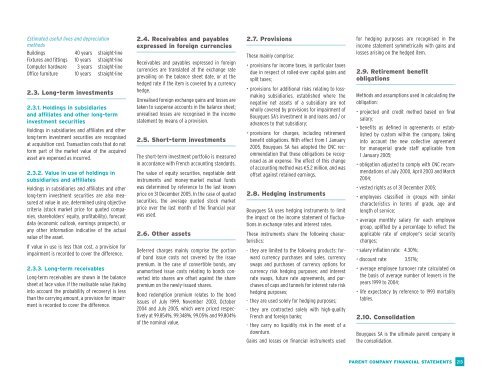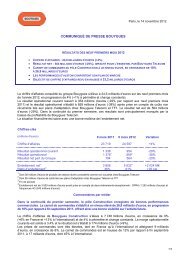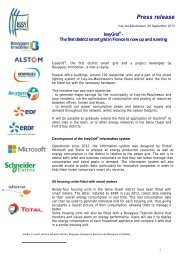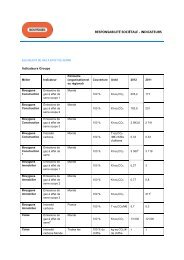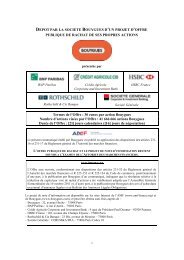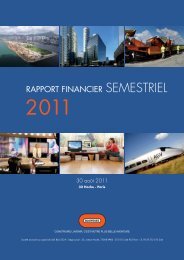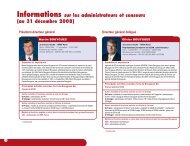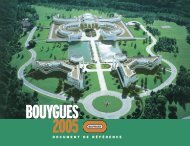A N N U A L R E P O R T - Bouygues
A N N U A L R E P O R T - Bouygues
A N N U A L R E P O R T - Bouygues
Create successful ePaper yourself
Turn your PDF publications into a flip-book with our unique Google optimized e-Paper software.
Estimated useful lives and depreciation<br />
methods<br />
Buildings 40 years straight-line<br />
Fixtures and fittings 10 years straight-line<br />
Computer hardware 3 years straight-line<br />
Office furniture 10 years straight-line<br />
2.3. Long-term investments<br />
2.3.1. Holdings in subsidiaries<br />
and affiliates and other long-term<br />
investment securities<br />
Holdings in subsidiaries and affiliates and other<br />
long-term investment securities are recognised<br />
at acquisition cost. Transaction costs that do not<br />
form part of the market value of the acquired<br />
asset are expensed as incurred.<br />
2.3.2. Value in use of holdings in<br />
subsidiaries and affiliates<br />
Holdings in subsidiaries and affiliates and other<br />
long-term investment securities are also measured<br />
at value in use, determined using objective<br />
criteria (stock market price for quoted companies,<br />
shareholders’ equity, profitability), forecast<br />
data (economic outlook, earnings prospects), or<br />
any other information indicative of the actual<br />
value of the asset.<br />
If value in use is less than cost, a provision for<br />
impairment is recorded to cover the difference.<br />
2.3.3. Long-term receivables<br />
Long-term receivables are shown in the balance<br />
sheet at face value. If the realisable value (taking<br />
into account the probability of recovery) is less<br />
than the carrying amount, a provision for impairment<br />
is recorded to cover the difference.<br />
2.4. Receivables and payables<br />
expressed in foreign currencies<br />
Receivables and payables expressed in foreign<br />
currencies are translated at the exchange rate<br />
prevailing on the balance sheet date, or at the<br />
hedged rate if the item is covered by a currency<br />
hedge.<br />
Unrealised foreign exchange gains and losses are<br />
taken to suspense accounts in the balance sheet;<br />
unrealised losses are recognised in the income<br />
statement by means of a provision.<br />
2.5. Short-term investments<br />
The short-term investment portfolio is measured<br />
in accordance with French accounting standards.<br />
The value of equity securities, negotiable debt<br />
instruments and money-market mutual funds<br />
was determined by reference to the last known<br />
price on 31 December 2005. In the case of quoted<br />
securities, the average quoted stock market<br />
price over the last month of the financial year<br />
was used.<br />
2.6. Other assets<br />
Deferred charges mainly comprise the portion<br />
of bond issue costs not covered by the issue<br />
premium. In the case of convertible bonds, any<br />
unamortised issue costs relating to bonds converted<br />
into shares are offset against the share<br />
premium on the newly-issued shares.<br />
Bond redemption premium relates to the bond<br />
issues of July 1999, November 2003, October<br />
2004 and July 2005, which were priced respectively<br />
at 99.854%, 99.348%, 99.05% and 99.804%<br />
of the nominal value.<br />
2.7. Provisions<br />
These mainly comprise:<br />
• provisions for income taxes, in particular taxes<br />
due in respect of rolled-over capital gains and<br />
split taxes;<br />
• provisions for additional risks relating to lossmaking<br />
subsidiaries, established where the<br />
negative net assets of a subsidiary are not<br />
wholly covered by provisions for impairment of<br />
<strong>Bouygues</strong> SA’s investment in and loans and / or<br />
advances to that subsidiary;<br />
• provisions for charges, including retirement<br />
benefit obligations. With effect from 1 January<br />
2005, <strong>Bouygues</strong> SA has adopted the CNC recommendation<br />
that these obligations be recognised<br />
as an expense. The effect of this change<br />
of accounting method was €5.2 million, and was<br />
offset against retained earnings.<br />
2.8. Hedging instruments<br />
<strong>Bouygues</strong> SA uses hedging instruments to limit<br />
the impact on the income statement of fluctuations<br />
in exchange rates and interest rates.<br />
These instruments share the following characteristics:<br />
- they are limited to the following products: forward<br />
currency purchases and sales, currency<br />
swaps and purchases of currency options for<br />
currency risk hedging purposes; and interest<br />
rate swaps, future rate agreements, and purchases<br />
of caps and tunnels for interest rate risk<br />
hedging purposes;<br />
- they are used solely for hedging purposes;<br />
- they are contracted solely with high-quality<br />
French and foreign banks;<br />
- they carry no liquidity risk in the event of a<br />
downturn.<br />
Gains and losses on financial instruments used<br />
for hedging purposes are recognised in the<br />
income statement symmetrically with gains and<br />
losses arising on the hedged item.<br />
2.9. Retirement benefit<br />
obligations<br />
Methods and assumptions used in calculating the<br />
obligation:<br />
• projected unit credit method based on final<br />
salary;<br />
• benefits as defined in agreements or established<br />
by custom within the company, taking<br />
into account the new collective agreement<br />
for managerial grade staff applicable from<br />
1 January 2005;<br />
• obligation adjusted to comply with CNC recommendations<br />
of July 2000, April 2003 and March<br />
2004;<br />
• vested rights as of 31 December 2005;<br />
• employees classified in groups with similar<br />
characteristics in terms of grade, age and<br />
length of service;<br />
• average monthly salary for each employee<br />
group, uplifted by a percentage to reflect the<br />
applicable rate of employer’s social security<br />
charges;<br />
• salary inflation rate: 4.30%;<br />
• discount rate: 3.57%;<br />
• average employee turnover rate calculated on<br />
the basis of average number of leavers in the<br />
years 1999 to 2004;<br />
• life expectancy by reference to 1993 mortality<br />
tables.<br />
2.10. Consolidation<br />
<strong>Bouygues</strong> SA is the ultimate parent company in<br />
the consolidation.<br />
PARENT COMPANY FINANCIAL STATEMENTS<br />
213


